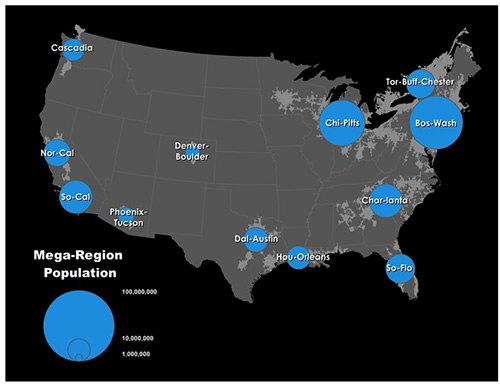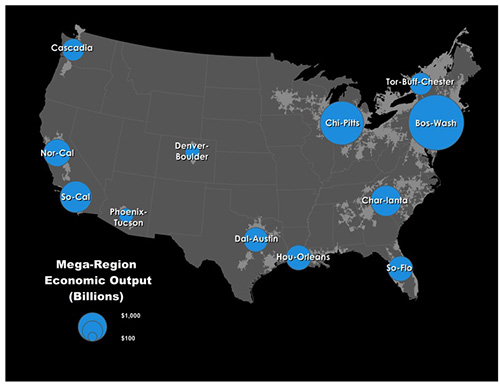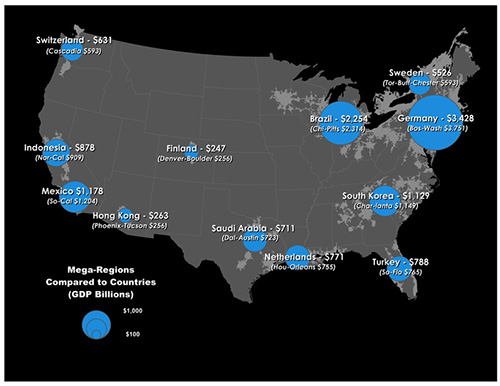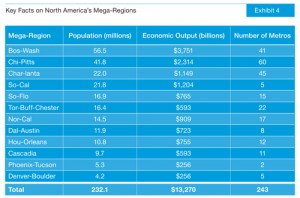Cities have always been the natural economic units of the world. But over the past several decades, clusters of cities and city regions have grown outward and into each other, forming mega-regions. More than just a collection of cities or one giant city, a mega-region is greater than the sum of its parts.
The earliest iteration of the idea of a mega-region dates back to 1957, when the economic geographer Jean Gottman coined the term “megalopolis” to describe the emerging economic hub that was the Boston-to-Washington corridor (he would publish a book with that title in 1961). Derived from the Greek and meaning “very large city,” the term came to be applied to a number of other regions: the great swath of California stretching south from San Francisco to San Diego; the vast Midwestern megalopolis that extends east from Chicago through Detroit and Cleveland and south to Pittsburgh; and the bustling Tokyo-Osaka region of Japan.
In 1993, the Japanese management expert Kenichi Ohmae wrote an influential Foreign Affairs article that argued that the globe’s natural economic zones, or “region states,” some of them crossing international boundaries, had replaced nation-states as the economic organizing units of what he famously dubbed the “borderless world” (his book, The End of the Nation State, followed two years later).
My own research, conducted with Timothy Gulden and Charlotta Mellander and published in 2007, identified the boundaries of these global mega-regions by using satellite images of the world at night. We defined a mega-region as a contiguous lighted area with more than one major city or metropolitan region that produced more than $100 billion in economic output. A 2009 report from the Regional Planning Association applied specific criteria of density, population, and economic growth at the level of counties to identify the major mega-regions of North America.
Exhibit 1: Mega-Region Population
This report uses metro level data to provide a portrait of the populations and economic outputs of the twelve mega-regions in the U.S. and Canada (comparable data for Mexico were unavailable). Population data are from the US Census Bureau American Community Survey and from Statistics Canada. The data on economic output for both U.S. metros and nations are from the most recent Metro Economies Report from the U.S. Conference of Mayors; Canadian data are from the Montreal Chamber of Commerce. Karen King and Zara Matheson of the Martin Prosperity Institute compiled the data and Matheson created the maps.
The Bos-Wash mega stretches some 500 miles down the East Coast, from Boston through New York, Philadelphia and Baltimore, to Washington, DC. It is home to 56.5 million people, more than 18 percent of all Americans, and generates $3.75 trillion in economic output, more than Germany. If Bos-Wash were a separate country, it would be the fourth largest nation in the world, behind only the U.S., China, and Japan.
Continuing from largest to smallest by population, Chi-Pitts extends north and west from Pittsburgh through Cleveland, Detroit, Indianapolis, Chicago, and Minneapolis, taking in more than 50 metros in all. This vast mega-region is home to 41.8 million people and generates $2.3 trillion in output. That makes it just a bit smaller than the United Kingdom, about the same size as Brazil, and bigger than all of Russia – equivalent to the world’s seventh largest nation.
Exhibit 2: Mega-Region Economic Output (Billions)
Home to 22 million people and with more than a trillion in economic output, Char-Lanta takes in 45 metros, including Atlanta, Raleigh, and Birmingham. Its economy is bigger than South Korea’s, placing it among the world’s fifteen largest economies.
So-Cal runs from LA through San Diego and is home to 21.8 million people and also generates more than one trillion in economic output (this mega also spills across the Mexican border into Tijuana and is thus even larger). Even excluding its Mexican component, its economy is bigger than all of Mexico’s and just a bit smaller than Spain’s, also placing it among the world’s fifteen largest economies.
So-Flo takes in the entire swath of Florida that includes Miami, Orlando and Tampa. It is home to 15 million people and produces more than $750 billion in economic output, making it about the same size as the Netherlands or Turkey. It too would rank among the world’s twenty largest economies.
Nor-Cal includes San Francisco, San Jose, Oakland and 14 other metros surrounding San Francisco Bay. It has a population of 13 million people and produces more than $900 billion in output, roughly the same as Indonesia and more than Turkey, also landing it among the world’s twenty largest economies.
Tor-Buff-Chester stretches north from Buffalo, and Rochester, taking in Toronto, Ottawa and Montreal in Canada. With a population of more than 16 million,1 it generates output of nearly $600 billion, more than Sweden’s, placing it among the world’s 25 largest economies.
Dal-Austin encompasses Dallas, Austin, and San Antonio, Texas. Its population is just under 12 million. It produces more than $700 billion in economic output, more than Sweden and or oil-rich Saudi Arabia, also ranking it among the 25 biggest economies in the world.
Hou-Orleans, the great energy-producing belt that stretches from Houston through Mobile, Alabama to New Orleans, is home to more than 10 million people. It produces more than $750 billion in economic output, about the same as the Netherlands, placing it among the world’s 25 largest economies.
Some researchers have suggested combining Houston, Dallas-Ft. Worth and Austin into a single “Texas Triangle,” a mega of 20 million people and $1.5 trillion in economic output, comparable to Australia and just a bit smaller than India and Canada.
Exhibit 3: Mega-Regions Compared to Countries (GDP Billions)
The Cascadia mega-region, which stretches up from Portland, Oregon through Seattle and into Vancouver, Canada, is home to nearly 10 million people. It generates economic output of about $600 billion, comparable to Switzerland, also placing it among the world’s top 25 nations.
Phoenix-Tucson is home to more than 5 million people and generates economic output of more than $250 billion, just slightly less than Hong Kong, making it one of the fifty largest economies in the world.
Finally, Denver-Boulder has 4.2 million people and $256 billion in economic output, more than Finland, Greece or Ireland. If it were a nation, it would also rank among the world’s 50 largest economies.
All told, these dozen mega-regions span 243 metropolitan areas in the U.S. and Canada, more than six in ten of all U.S. metros. They have a combined population of more than 230 million people, including 215 million from the United States or 70 percent of the U.S. population. Together, they produce more than $13 trillion dollars in economic output, equivalent to three-quarters of America’s total GDP.
Exhibit 4: Key Facts on North America’s Mega-Regions
1 This estimate is low as it includes only larger Canadian metros.
Download this Insight (PDF)



